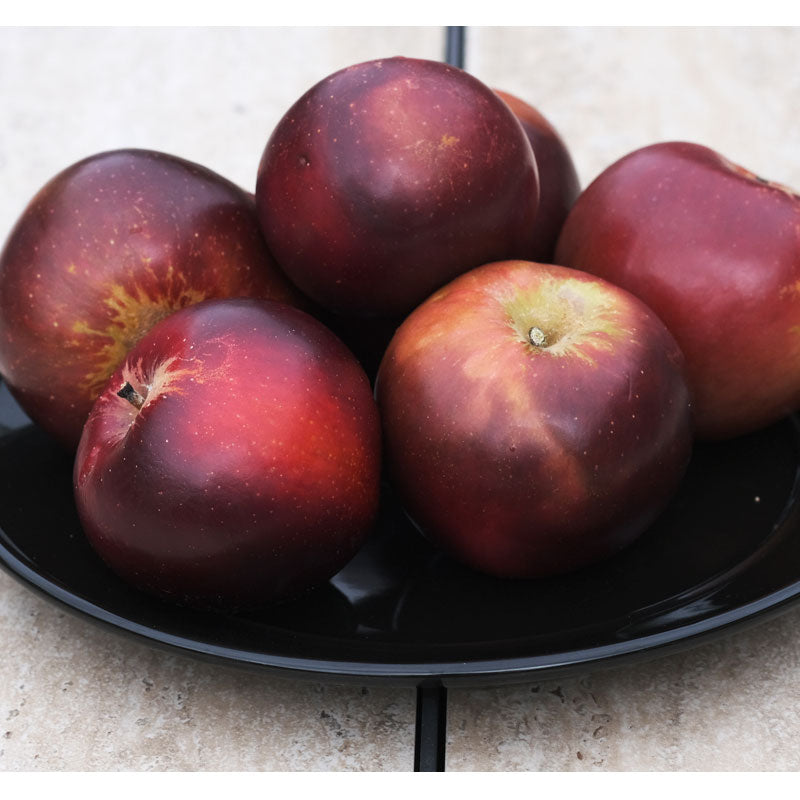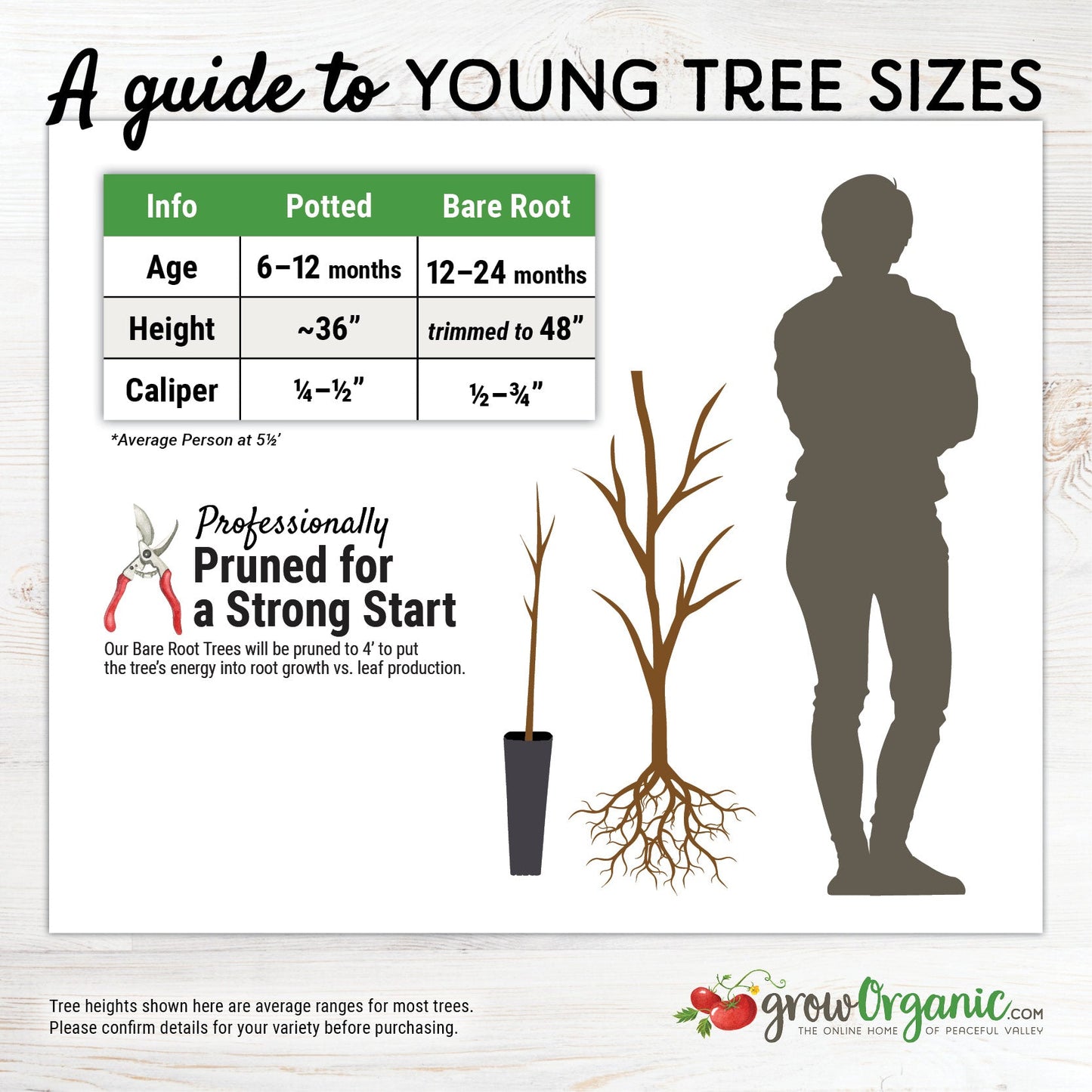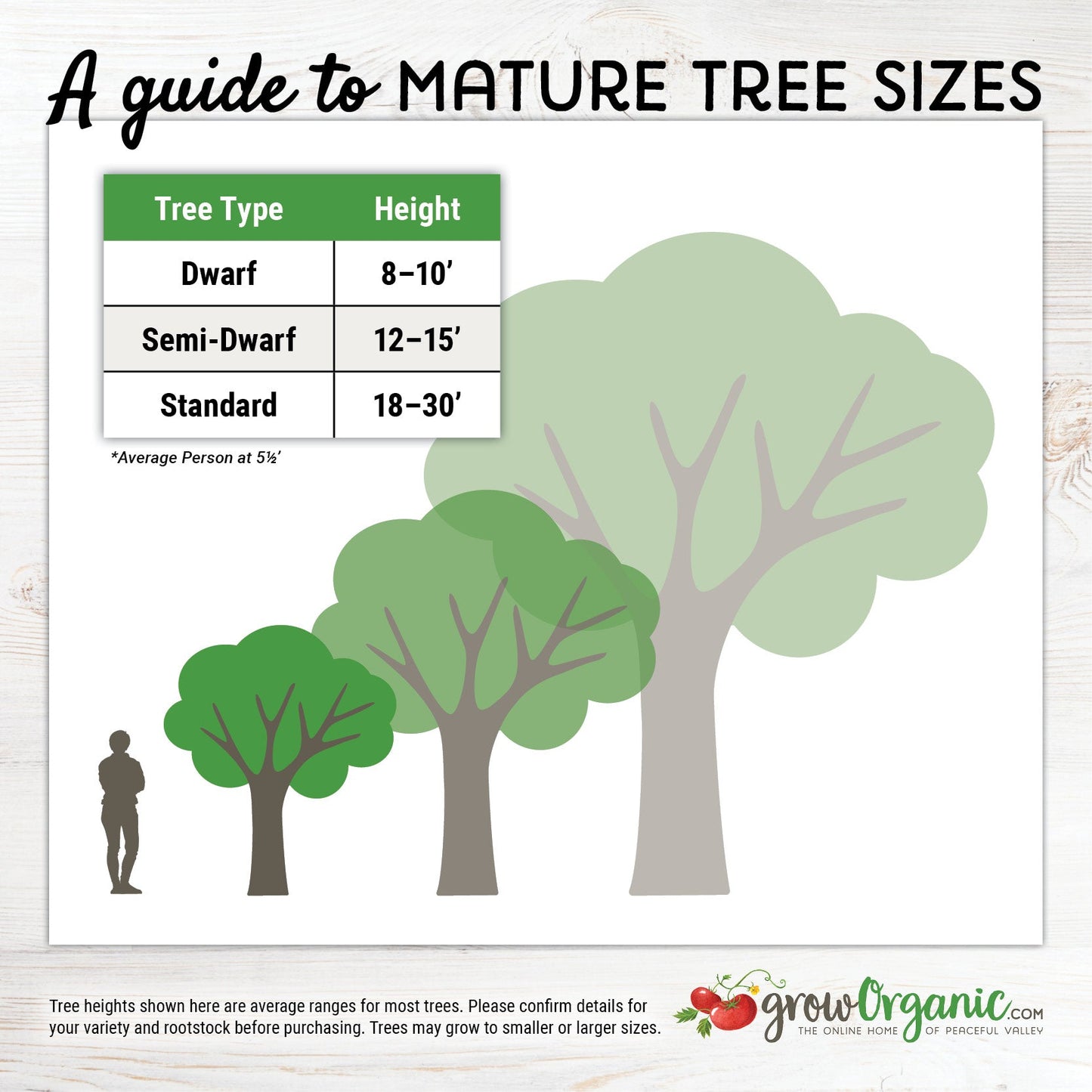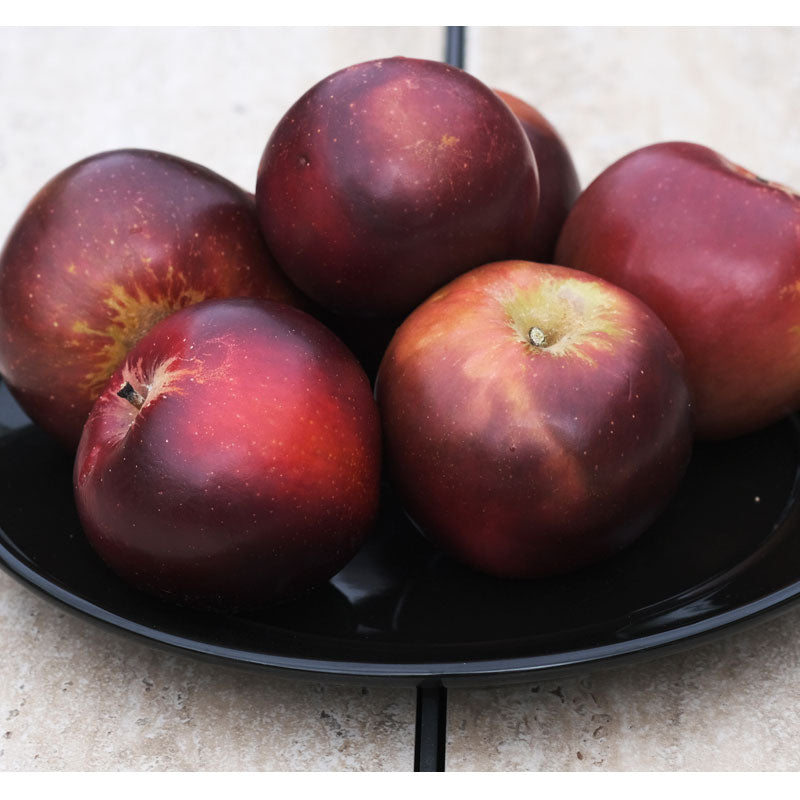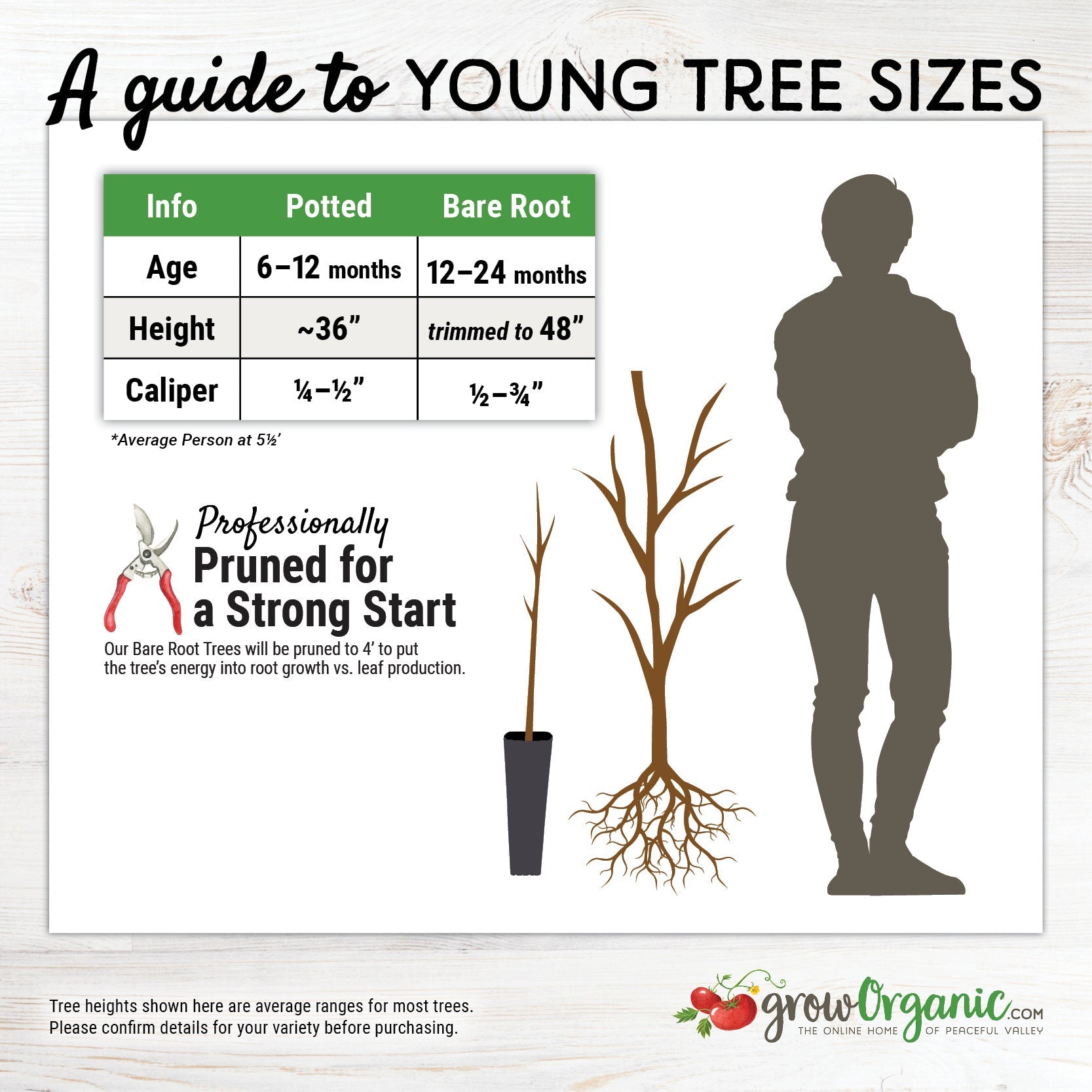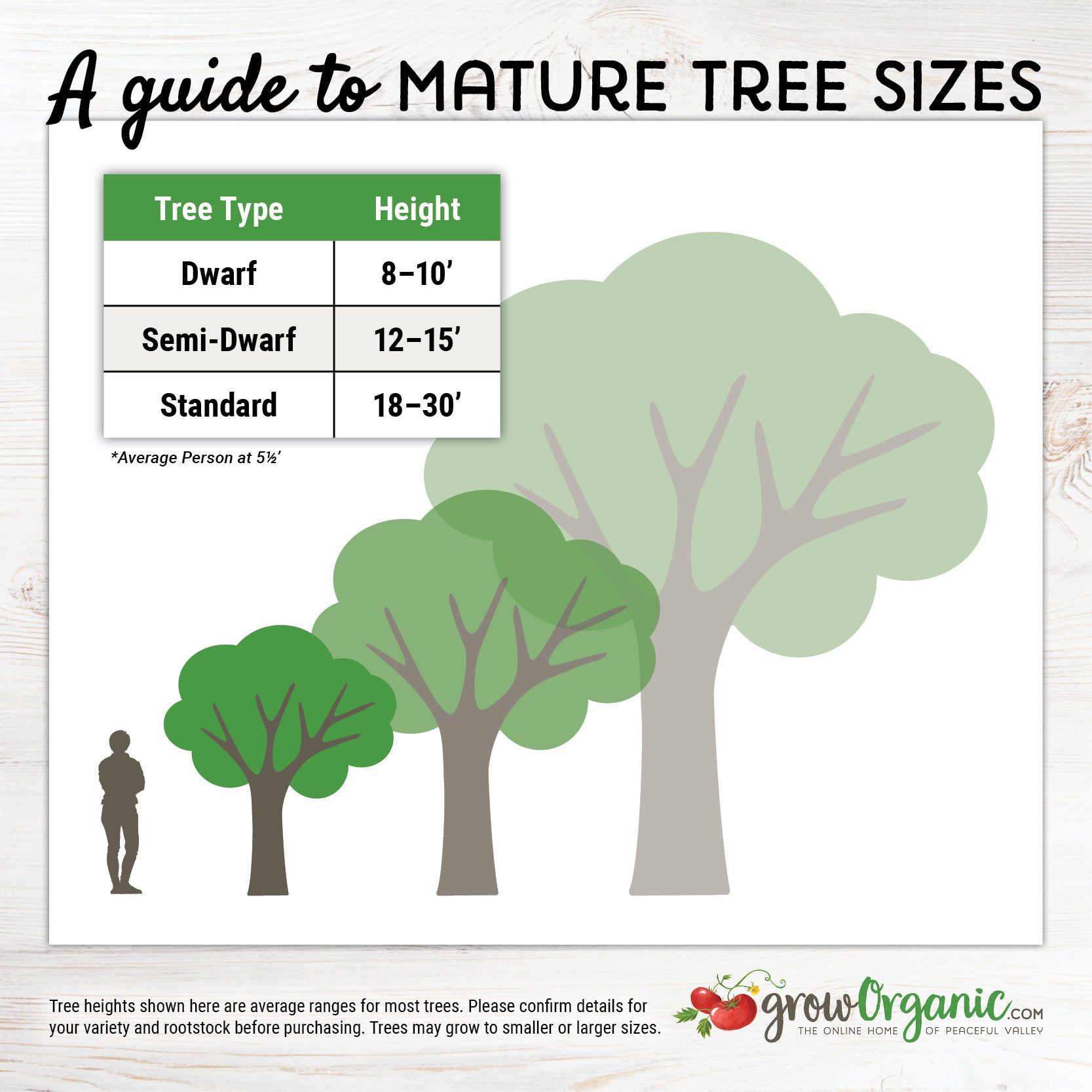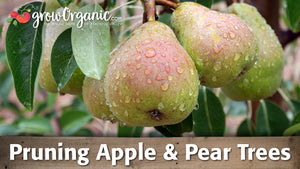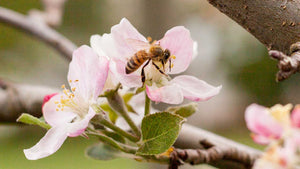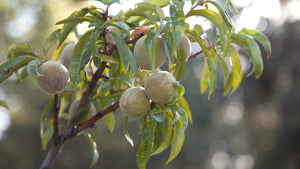Item Number: FT015
Arkansas Black Spur Apple Tree
Arkansas Black Spur Apple Tree
Great for Cider or Storage!
Semi-Dwarf on M111 rootstock.
Growing Zones: Suitable for USDA zones 5-8.
Chill Requirements: Requires around 500-700 chill hours for optimal fruiting.
Bloom Time: Typically blooms late in the spring.
Harvesting Dates: Harvesting usually occurs between October 5 to October 25.
Looks: Arkansas Black Spur Apples are medium-sized with a dark red to almost black skin. The flesh is crisp, and the flavor improves with age.
Personality: Known for its distinctive, almost "foxy" flavor, excellent for cooking, cider making, and fresh eating after storage.
Facts of Note: The variety is considered an heirloom from Arkansas, dating back to the 1830s. It needs storage to achieve its full flavor potential.
Pollinator: Partially self-fruitful but benefits from cross-pollination from varieties like Golden Delicious or Granny Smith for better yields.
Ideal Soil Temperatures: Arkansas Black Spur Apples prefer soil temperatures between 60°F to 75°F (15°C to 24°C).
Planting Depths: Plant young trees at the same depth they were in the nursery container.
Germination Periods: Typically grown from grafted trees rather than seeds. Apple seeds can take a few weeks to a few months to germinate.
Height at Maturity: These trees can reach heights of about 15-20 feet.
Days to Maturity: Begins fruiting in about 2 years, but full production may take 5-7 years.
Sun/ Shade: Requires full sun for optimal growth and fruit production.
Spacing After Thinning: Space trees 20-25 feet apart to allow for proper growth and airflow.Arkansas Black Spur Apple Tree,
Growing Conditions:
Arkansas Black Spur Apple Trees flourish in Zones 5 to 8 and thrive in regions with approximately 500 to 700 chill hours. They bloom late in the season, making them suitable for areas with typical Central Valley California weather patterns. Their harvest window spans from October 5 to October 25, producing large apples adorned with unique dark red skin.
Characteristics:
These apples boast a personality characterized by very crisp flesh and a sharp flavor that matures and improves over time. Their distinct, outstanding flavor unfolds after an extended period in storage. Initially, the medium-sized fruit exhibits very dark red to nearly black skin, intensifying to a deep black hue during storage.
Culinary Uses:
The Arkansas Black Spur Apple is a versatile cultivar, revered for its excellent cooking properties and often utilized in the production of delectable ciders. Its distinct flavor profile, often described as "foxy," adds depth to culinary creations, especially in cider blends and various apple-based recipes.
Historical Roots:
Originating from the apple-growing boom in Benton and Washington counties during the 1830s to the early 1900s, this apple variety played a significant role in shaping Arkansas's apple-growing heritage. Despite setbacks like the Civil War, apple orchards continued to thrive, establishing Benton and Washington counties as the largest apple-growing regions in the United States by the late 1800s.
Parentage and Identification:
While the exact cross remains unidentified, the prevalent belief is that the Arkansas Black Spur Apple is a seedling of Winesap and an unknown parent. Although frequently confused with the Arkansas Black Twig variety, they are distinct cultivars, although Arkansas Black Twig has been speculated as a possible parent to the Arkansas Black Apple.
Growth and Pollination:
These trees start fruiting within two years, showcasing their productive nature. While partially self-fruitful, they fare better with a pollenizer. Varieties like Golden Delicious or Granny Smith serve as suitable pollenizers, enhancing fruit set and yield.
Cultivating the Arkansas Black Spur Apple Tree offers not just a fruitful addition to gardens but also a connection to a storied past entrenched in the apple-growing history of Benton County, Arkansas. With its unique flavor and historical significance, this apple tree stands as a testament to the rich heritage of apple cultivation in the United States.Zones: 5-8
- Chill hours: 500-700
- Bloom Time: Late (Based on typical Central Valley California weather)
- Harvest: October 5 - October 25
- Looks: Large, apples with unique dark red skin.
- Personality: Very crisp flesh, the sharp flavor improves with age.
- Facts of note: An heirloom apple variety from Arkansas that produces a distinct, outstanding flavor after an extended time in storage. The medium-sized fruit is very dark red to almost black skinned but becomes nearly black during storage. Very uniquely flavored, often described as foxy, this apple must be stored to achieve its wonderful flavor. The Arkansas Black is an excellent cooking apple and is quite often used as a blending apple in delicious ciders. Arkansas Black Apple traces its root to the Apple growing boom in Benton and Washington counties in Arkansas state from the 1830’s to the early 1900’s. The Ben Davis Apple was the backbone of the Arkansas apple growers. Despite the damage done by the Civil War the Arkansas apple orchards continued to grow and by the late 1800’s Benton and Washington counties were the largest apple growing regions in the United States. The exact cross has yet to be Identified, but the most common belief is that it is a seedling of Winesap and unknown Parent. Though often confused with the variety Arkansas Black Twig these are not the same varieties, but Arkansas Black Twig has been cited as a possible parent to the Arkansas Black Apple. Begins to fruit in 2 years.
- Pollination: Partially self-fruitful, does much better with pollenizer. Golden Delicious or Granny Smith work well.
Visit our Fruit Tree Central for a listing of all our fruit tree videos and articles.
Visit Tree Characteristics for a listing of all our fruit & nut tree growing characteristics.


Check Your Zone Compatibility:
Compatible with your zone.
Growing Zone for
,

Our Guarantee To You
Since 1976, we've served our customers at every stage of growing. Please contact us at any time. We are happy to support and assist you.
Description
Description
Semi-Dwarf on M111 rootstock.
Growing Zones: Suitable for USDA zones 5-8.
Chill Requirements: Requires around 500-700 chill hours for optimal fruiting.
Bloom Time: Typically blooms late in the spring.
Harvesting Dates: Harvesting usually occurs between October 5 to October 25.
Looks: Arkansas Black Spur Apples are medium-sized with a dark red to almost black skin. The flesh is crisp, and the flavor improves with age.
Personality: Known for its distinctive, almost "foxy" flavor, excellent for cooking, cider making, and fresh eating after storage.
Facts of Note: The variety is considered an heirloom from Arkansas, dating back to the 1830s. It needs storage to achieve its full flavor potential.
Pollinator: Partially self-fruitful but benefits from cross-pollination from varieties like Golden Delicious or Granny Smith for better yields.
Ideal Soil Temperatures: Arkansas Black Spur Apples prefer soil temperatures between 60°F to 75°F (15°C to 24°C).
Planting Depths: Plant young trees at the same depth they were in the nursery container.
Germination Periods: Typically grown from grafted trees rather than seeds. Apple seeds can take a few weeks to a few months to germinate.
Height at Maturity: These trees can reach heights of about 15-20 feet.
Days to Maturity: Begins fruiting in about 2 years, but full production may take 5-7 years.
Sun/ Shade: Requires full sun for optimal growth and fruit production.
Spacing After Thinning: Space trees 20-25 feet apart to allow for proper growth and airflow.Arkansas Black Spur Apple Tree,
Growing Conditions:
Arkansas Black Spur Apple Trees flourish in Zones 5 to 8 and thrive in regions with approximately 500 to 700 chill hours. They bloom late in the season, making them suitable for areas with typical Central Valley California weather patterns. Their harvest window spans from October 5 to October 25, producing large apples adorned with unique dark red skin.
Characteristics:
These apples boast a personality characterized by very crisp flesh and a sharp flavor that matures and improves over time. Their distinct, outstanding flavor unfolds after an extended period in storage. Initially, the medium-sized fruit exhibits very dark red to nearly black skin, intensifying to a deep black hue during storage.
Culinary Uses:
The Arkansas Black Spur Apple is a versatile cultivar, revered for its excellent cooking properties and often utilized in the production of delectable ciders. Its distinct flavor profile, often described as "foxy," adds depth to culinary creations, especially in cider blends and various apple-based recipes.
Historical Roots:
Originating from the apple-growing boom in Benton and Washington counties during the 1830s to the early 1900s, this apple variety played a significant role in shaping Arkansas's apple-growing heritage. Despite setbacks like the Civil War, apple orchards continued to thrive, establishing Benton and Washington counties as the largest apple-growing regions in the United States by the late 1800s.
Parentage and Identification:
While the exact cross remains unidentified, the prevalent belief is that the Arkansas Black Spur Apple is a seedling of Winesap and an unknown parent. Although frequently confused with the Arkansas Black Twig variety, they are distinct cultivars, although Arkansas Black Twig has been speculated as a possible parent to the Arkansas Black Apple.
Growth and Pollination:
These trees start fruiting within two years, showcasing their productive nature. While partially self-fruitful, they fare better with a pollenizer. Varieties like Golden Delicious or Granny Smith serve as suitable pollenizers, enhancing fruit set and yield.
Cultivating the Arkansas Black Spur Apple Tree offers not just a fruitful addition to gardens but also a connection to a storied past entrenched in the apple-growing history of Benton County, Arkansas. With its unique flavor and historical significance, this apple tree stands as a testament to the rich heritage of apple cultivation in the United States.Zones: 5-8
- Chill hours: 500-700
- Bloom Time: Late (Based on typical Central Valley California weather)
- Harvest: October 5 - October 25
- Looks: Large, apples with unique dark red skin.
- Personality: Very crisp flesh, the sharp flavor improves with age.
- Facts of note: An heirloom apple variety from Arkansas that produces a distinct, outstanding flavor after an extended time in storage. The medium-sized fruit is very dark red to almost black skinned but becomes nearly black during storage. Very uniquely flavored, often described as foxy, this apple must be stored to achieve its wonderful flavor. The Arkansas Black is an excellent cooking apple and is quite often used as a blending apple in delicious ciders. Arkansas Black Apple traces its root to the Apple growing boom in Benton and Washington counties in Arkansas state from the 1830’s to the early 1900’s. The Ben Davis Apple was the backbone of the Arkansas apple growers. Despite the damage done by the Civil War the Arkansas apple orchards continued to grow and by the late 1800’s Benton and Washington counties were the largest apple growing regions in the United States. The exact cross has yet to be Identified, but the most common belief is that it is a seedling of Winesap and unknown Parent. Though often confused with the variety Arkansas Black Twig these are not the same varieties, but Arkansas Black Twig has been cited as a possible parent to the Arkansas Black Apple. Begins to fruit in 2 years.
- Pollination: Partially self-fruitful, does much better with pollenizer. Golden Delicious or Granny Smith work well.
Visit our Fruit Tree Central for a listing of all our fruit tree videos and articles.
Visit Tree Characteristics for a listing of all our fruit & nut tree growing characteristics.
Apples are generally late blooming. Need full sun, well-drained soil, and moderate fertility. Thin fruit to maximize quality and size. Susceptible to codling moth, apple scab, powdery mildew, and gophers. Generally cross-fertile, which means that the variety is not pollinated by itself, but by a different variety of the same fruit. Three or more varieties are best. Browse all our apple trees for sale.
Please Note: Although most of our bare-root trees arrive to our warehouse in mid-December, there are a few varieties that will not arrive until mid-January. If you order any of those varieties along with varieties that arrive in mid-December, your order will be delayed for shipment until mid-January. If you'd like us to split your shipments, please contact us at (888) 784-1722 or orderdesk@groworganic.com. Additional shipping charges will apply.
Shipping Information
Shipping Information
Cannot ship to the following states: HI, AK, PR, GU, VI
Cannot ship via USPS.
Cannot ship via SmartPost.
Shipping Weight: 5.0 lb
Dimensions: 55.5"L x 7.3"W x 2.75"H
Features
Features
- Good Keeper
- Self-fruitful
Characteristics
Characteristics
Planting & Care
Planting & Care
Useful Information
Useful Information
Guarantee
Guarantee
Limited Dormant Tree & Plant Guarantee
* Claim deadline is June 15th
We guarantee that your dormant tree or plant will arrive in good, viable condition. If your tree arrives in substandard condition, notify us within 3 days of delivery. Please email pictures of the box, inside packaging, the tree and its roots to helpdesk@groworganic.com. We will investigate your claim and process a request to exchange or refund the damaged product.
If your dormant tree or plant has not grown new leaves by June 15th, you may be eligible for our Limited Dormant Tree & Plant Guarantee. This guarantee provides for a store credit for the purchase price of the tree, excluding shipping. Please see the Instructions below.
Important Dates:
- April 1st Dormant trees/plants must be planted in the ground
- May 15th Perform scratch test, if no new leaves have grown
- June 15th Deadline to apply for a dormant tree/plant credit
All required documentation must be received by June 15th for your claim to be considered. Claims or documentation received after June 15th will be denied, without exception. Instructions listed below
Terms and Conditions
We cannot guarantee that your tree or plant will remain alive and healthy after it is received, or bear fruit as there are too many variables in your environment that are beyond our control (i.e. soil preparation, weed and pest control, proper irrigation, chill hours, compatible hardiness for your growing zone, proper choice of pollinator, extreme weather, rodent damage, disease, etc.).
We cannot guarantee that we will be able to provide a replacement tree/plant of the same species either that same growing season or in future years. Customers are responsible for all shipping fees associated with replacement trees and plants.
If we determine that the tree you purchased directly from us is not viable, we will issue you a store credit (not a refund) for the purchase price of the affected dormant tree or plant. Shipping is not included in the dormant tree/plant guarantee. Store credits can be used to purchase any product we sell and are valid for use only until July 1st of the following year.
Historically, 98% of our dormant trees and plants grow and thrive when they have been cared for and planted using our growing guides. Dormant trees and plants must be planted in the ground by April 1st in order to be eligible for credit. If the ground in your area is still frozen solid, you may temporarily plant your tree or plant in a pot.
Potted, non-dormant trees or plants are excluded from this guarantee as they are not dormant at the time of shipment. Evergreen trees such as citrus, avocado and olive trees are not available for credit under the Dormant Tree and Plant Guarantee.
Instructions
We guarantee that your dormant fruit tree or plant will leaf out, if you care for it according to our growing guides. In the unlikely event that your dormant tree or plant does not have leaves by May 15th, follow these simple steps to apply for a store credit:
Before you call or email, please perform a “scratch test” to determine if the tree or plant is still alive. This video shows how to check for live tissue under the bark. Scratch tests need to be done a few inches above and below the graft.
Green Cambium Layer / Living Trees
If the cambium layer under the bark is green, give your tree a little more time. It is still alive, but hasn’t come out of dormancy yet. Check to make sure that it is getting the right amount of deep root water, enough sunlight and that the weather is warm enough for that type of tree/plant to come out of dormancy. Every tree has its own personality and will come out of dormancy at different times. Be sure to submit the required documentation listed below by June 15th, if it doesn’t grow leaves.
Brown Cambium Layer / Dead Trees
If the scratch test shows a brown cambium layer or if your dormant tree/plant doesn’t have leaves by June 1st, please email us at helpdesk@groworganic.com. All required documentation listed below must be received by June 15th for your claim to be considered. To be considered for the guarantee claim, all required documentation must be received by June 15th. Incomplete submissions will be denied.
Required Documentation
- Order number
- Name of dormant tree/plant and the quantity affected
- Photos of each tree or plant showing:
- The roots (tree or plant must be pulled out of the ground)
- The scratch test areas
- The entire tree/plant
We reserve the right to not issue credit for items that have already been replaced. We also reserve the right to require photographic evidence that the tree/plant was not killed by root rot, rodent or mechanical damage.
Share
